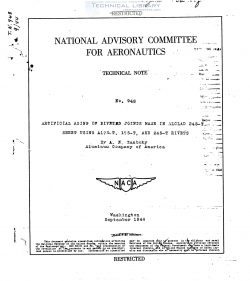naca-tn-948
- Version
- 188 Downloads
- 292.07 KB File Size
- 1 File Count
- December 1, 2016 Create Date
- December 1, 2016 Last Updated
National Advisory Committee for Aeronautics, Technical Notes - Artificial Aging of Riveted Joints Made in Alclad 24S-T Sheet Using A175-T, 17S-T, and 24S-T Rivets

Artificial aging of 248—T and 24S—RT sheet to improve “
their mechanical preperties has been develOped to the point
that it is finding considerable commercial application (refer—
ence l). Ordinarily the sheet is artificially aged before it
is assembled into a structural part, but some manufacturers
have expressed an interest in the artificial aging of complete
assemblies. Since most aircraft structural assemblies are
riveted, such a procedure would involve artificially aging the
driven rivets which might or might not be of 24S alloy. It
seems desirable, therefore, to obtain some information on the
effect of artificial aging on the strengths of driven rivets
of the allOys used commercially for rivets; namely, A17S-T,
l7S—T, and 24s-T.
The object of this investigation was to study the effectv
of artificial aging On the shear strength of Joints prepared
from alclad 24S—T sheet using A17S~T, l7S—T, and.24$—T rivets.
The sheet used in this investigation was 0,06e-inch—thick
alclad 24$~T produced in accordance with specification AN-A—ls
(amended Oct. 11, 1943). The rivets were 1/8 by 5/16—inch
button head and of the alloys commonly employed in airplane
construction: A17S—T, 17S—T, and see-r.
The effect of the artificial aging treatment on the rivets
was measured by the changes produced in the shear strength of
the rivets. The details of the specimens are shown in figure 1.
A total of 40 specimens was prepared, with all rivets
headed by using the driving lead necessary to give flat driven
heads 3/16 inch in diameter.' Ten specimens were prepared for
each of the following conditions:
(1) A17S—T rivets, driven as received with approximately
_ 2000 pound drivingload for each rivet
(2) lVS—T rivets, reheat-treatment, quenched, refriger—
ated, and driven immediately with 1800 pound
driving lead per rivet.
(3) lVS-T rivets, reheat—treated, quenched, and allowed
to age 6 days at room temperature before being
driven with 2400 pound driving load per riVet
(4) 245—T rivets, reheat—treated, quenched, refriger— _
ated, and driven immediately with 2400 pound
driving load per rivet
The rivets were driven with the aid of a sub—press in a 40,000—
pound capacity Amsler testing machine (type 20, ZBDA, Serial No,
4318). None of the rivets in this investigation deve10ped any
head cracks.
| File | Action |
|---|---|
| naca-tn-948 Artificial Aging of Riveted Joints Made in Alclad 24S-T Sheet Using A175-T, 17S-T, and 24S-T Rivets.pdf | Download |

Comment On This Post